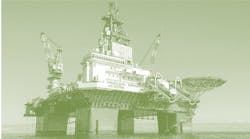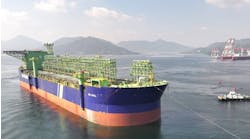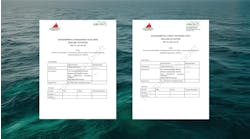R. Tepper, P. BoonenA slimhole acoustic logging-while-drilling (LWD) tool has expanded the range of LWD applications to boreholes as small as 5 7/8-in. in diameter. The typical applications of acoustic logging data such as seismic time-to-depth correlation, abnormal pore pressure prediction, and acoustic porosity computation are now possible while drilling small size boreholes.
Halliburton Energy ServicesC. Bean
Chevron USA Production CompanyD. Hollon
Texaco Inc.
A combination of slimhole LWD resistivity and acoustic tools provides all the data necessary for formation evaluation while drilling without the presence of radioactive sources in the bottom hole assembly.
The slimhole version of the acoustic LWD tool is a 4-3/4-in.-OD tool for use in 5-3/4- to 6-3/4-in. boreholes. The acoustic outlay of the tool is similar to the 6 3/4- and 8-in. OD tools. Two piezoelectric transmitters are offset four ft above and below an array of four receivers at 1-ft spacing.
An ultrasonic transducer is centered in the receiver array to measure stand-off. The transmitters and receivers operate in the 10- to 20-kHz range, similar to wireline acoustic tools. The transmitters and receivers are aligned along one side of the tool unlike the omnidirectional wireline tools. This configuration has a few important consequences related to waveform recording and tool response in casing.
The dual-transmitter design of the tool provides redundancy in the sonic measurement to furnish quality control and borehole compensation. Two independent slowness measurements are made at each depth level from an upper- and a lower- transmitter firing. The waveform arrays are semblance processed downhole, and the two slownesses together with a standoff measurement can be sent uphole in real time. Waveform sets of each of these slownesses are recorded for reprocessing at surface. Differences between the slowness computed from the upper and lower transmitter firings can be attributed to tool malfunction, processing difficulties such as tool mode removal or borehole conditions. The upper and lower transmitter slowness comparison provides a similar service to the repeat section in wireline logging.
Borehole compensation
A semblance-guided procedure for borehole compensation becomes extremely important in LWD operations while reaming or while running in the hole after a bit trip. The effects of borehole deterioration on acoustic logs over time have been demonstrated. A comparison between LWD and wireline acoustic logs has shown that both logs are affected by bad borehole conditions, but that the LWD logs can be better because of their earlier recording.Another reference has indicated that borehole deterioration can occur soon after drilling, as fast as a half hour after the drill bit has penetrated the formation. With the acoustic tool located behind the gamma ray, resistivity and directional packages, this half hour often elapses before the acoustic tool traverses the newly drilled formation. Thus, the borehole compensation is of immediate importance.
The offset between the transmitter and the first receiver is a compromise between mechanical configuration and acoustic data quality. A 5.5-ft effective offset allows for a dual-transmitter, borehole-compensated transducer configuration to be fitted in a 30-ft drill collar. The signal-to-noise ratio decreases sharply with increasing offset.
To maintain adequate signal strength at the receivers, techniques such as waveform stacking are used to reduce noise. However, stacking of the waveform data is not recommended in acoustic LWD tools because waveforms may be shifted in time.
This shift is due to variation of the tool position in the wellbore, to borehole irregularities, or to both, and is related to the directional nature of the LWD acoustic sources, as compared to the radial wireline sources. The 4, 5, 6, and 7-ft offset does not require data stacking. A longer transmitter to receiver offset provides a possibility to read somewhat deeper in the formation provided a low velocity altered zone exists around the borehole.
Modeling has shown that a tool with an effective 5.5 ft offset measures the unaltered formation arrivals as the first arrival with altered zone diameters of up to 6 in. with a 10 microseconds/ft difference in slowness between altered and unalterd zones. Consistent differences of 7 microseconds/ft have been described. The semblance processing is able to resolve multiple peaks when the first arrival is not the required formation arrival.
Dislodged casing
The first case study well was an exploration well located in over 270 ft of water offshore Louisiana. The well was drilled with 5 different hole sizes from 21-in. down to 6 1/2-in. The small borehole diameter necessitated to run a combination of slimhole LWD tools. The slimhole sonic log was selected next to the resistivity measurement to avoid running radioactive sources in the small diameter borehole.The first indication of a problem after cementing the 9 5/8-in. casing string, was the inability to obtain a successful leak-off-test (LOT). After numerous failed attempts to squeeze cement into the shoe, a data dump of the recorded slim resistivity/sonic combination log was plotted and analyzed. These LWD data were obtained while drilling-out cement after the 9 5/8-in. casing cement job. These log data were compared to the real-time resistivity log recorded during the initial drilling phase of the well.
The post-cement job resistivity data recorded across the lower part of the 9 5/8-in. casing string displayed the expected erratic behavior in the casing:
- 90 ft interval, which appeared to consist of an open hole shale zone
- Very erratic response section of about 200 ft
- Short section showing formation response.
The sonic slowness in the open hole shale section reads between 100-110 microseconds/ft, while the slowness in the cased sections of the well reads around 50 microseconds/ft. It appeared that the bottom 200 ft section of the 9 5/8-in. casing string had fallen about 90 ft into a drilled portion of the well.
Although the problem was serious, the operating company was relieved to discover the cause of the problem so that appropriate corrective action could be implemented. It is interesting to note that the compressional slowness in the casing section is about 50 sec/ft. We can safely assume that the casing is not cemented properly, and hence we would expect a casing arrival of about 57 sec/ft. It appears that the directional acoustic LWD source doesn't excite the plate wave in the casing that is traditionally seen with the radial sources of the wireline sonic tools. The plate wave travels at about 17,500 ft/sec, or 57 sec/ft. The casing wave appears to be the real extension wave of steel traveling at about 20,000 ft/sec, or 50 sec/ft.
A possible application of the slim LWD sonic would be to run it while drilling out cement and using the delta responses as an indicator of any free pipe sections, which might require remedial action before drilling ahead.
Pressure detection
The second example involves the use of the slim sonic tool to help predict the onset of supernormal pressure in another offshore Gulf of Mexico well. The objective of this well was to test a Mid-Miocene shelf sand located on the upthrown side of a fault with approximately 100 ft of vertical displacement.The well was drilled offset to a vertical well in which wireline resistivity and sonic were recorded. The fault and supernormal pressure encountered in the offset well were expected to be observed in the target well, but the expected intersection point of the fault was not well defined. The fault was expected to coincide with the top of supernormal pressure in the target well at approximately 10,900 ft measured depth.
The LWD resistivity was to be monitored closely at fairly low rates of penetration beginning about 50 ft above the expected location of the fault and the onset of supernormal pressure. At this point, a rock bit trip was made and the LWD sonic collar was added to the bottom hole assembly.
While the resistivity data were pulsed up in real time, the sonic log was being recorded in memory for later review and comparison to the resistivity data. Using offset well data, the resistivity was able to indicate the onset of supernormal pressure, but due to the presence of sandy shales and therefore variable gamma ray responses, the interpretation was not clear cut.
A data dump of the memorized sonic data and its subsequent comparison to the resistivity log showed that the sonic data in this case provided a clearer picture of the change in pressure regimes. A true vertical depth (TVD) pressure plot of both the LWD resistivity and sonic log data also shows that sonic derived formation pressure and fracture gradient data compared better to the initial production test in a pay sand below the top of supernormal pressure.
The capability to transmit real-time acoustic slowness data means that the LWD sonic tool will now be applicable for detecting the presence of supernormal pressure while drilling. A comparison of LWD derived pressure data to offset wireline resistivity and sonic derived pressure plots provides evidence that sonic data are at least as effective as, and possibly more robust a supernormal pressure detection technique than the real time resistivity log.
Since the resistivity log can be adversely affected by highly saline borehole fluids and a reduced dynamic range between sand and shale resistivity as formation pressure increases, the sonic appears to be the tool of choice as the more accurate equivalent mud weight estimator. In addition, the ability to determine a reliable porosity log for the interval of interest saved the rig time and expense of a wireline log run in a slim hole.
Other applications
Another important drilling application of slim LWD sonic logging is the generation of near real-time synthetic seismic traces for well-to-seismic correlation. This application is useful in exploration areas, or in development plays where there is significant faulting or other complications with the surface seismic interpretation.The ability to obtain real-time transmitted slowness data while drilling that can be quickly transposed into synthetic seismic traces (ideally requires a bulk density input) allows the user to check the actual well path trajectory against the planned target locations on the seismic section.
This provides the flexibility needed to decide if continuing on the current drill path will result in the intersection of the target zones. The ability to modify the drilling trajectory could save a subsequent sidetrack or turn a missed opportunity into a successful well.
Systematic differences have been reported between LWD and wireline acoustic data. In an offshore Gulf of Mexico well, drilled using an oil-based mud, shales displayed the largest systematic discrepancy (4 to 7 microseconds/ft) between the two data sets.
Shale alteration over time, even in an oil-based mud, may be the reason for this difference. This slowness discrepancy adds up to a 10 millisecond difference in integrated travel time over a 2,000 ft example affecting the seismic time-to-depth correlation by as much as 150 ft.
The use of the slim LWD sonic for porosity evaluation can replace the need for wireline logging runs. This is particularly crucial when hole angles exceed 50° where a drillpipe assisted wireline operation may be required. Aside from saving rig time by avoiding a wireline run, the advantages of running sonic logs for porosity is that you do not put radioactive sources in the hole as you must with either wireline or LWD density and neutron logging.
The tight standoff constraints that often limit the effectiveness of density logs, particularly in rugose or washed out boreholes is somewhat alleviated by use of the LWD sonic tool. As a comparison, no more than 1/2 in. of standoff can be tolerated by density logging techniques while 1/2 - 3 in. is the desirable standoff range for the sonic.
This means that the sonic is likely to be a more effective porosity device when the hole is irregular or enlarged. If porosity data are required, an opportunity to get an accurate porosity measurement could save a wireline logging run later in time when it's likely that hole conditions will have further deteriorated.
Conclusions
The slim LWD sonic has proven to be a versatile tool providing reliable data that can be trusted to provide information valuable to the rig operations team. In the two examples presented, we have shown that the LWD sonic data was able to provide valuable backup to the LWD resistivity log when it was considered to have been questionable.The LWD sonic also provided valuable formation evaluation data of a sufficiently high quality to render a costly wireline log run unnecessary. Aside from showing fallen casing, helping to pinpoint the top of supernormal pressure, and providing wireline replaceable quality formation evaluation data in hole sizes as small as 5 7/8-in. the slim LWD sonic tool has additional advantages.
The ability to secure quality porosity data without the need for radioactive sources or short borehole standoff constraints provides an advantage over nuclear technology for this purpose. The ability to obtain acoustic data prior to most borehole degradation, particularly at very high inclination angles without drillpipe assist wireline techniques and is often a quality and cost advantage over wireline technology. The combinability of this system with real time borehole pressure measurement devices is highly desirable for equivalent circulating density and effective mud weight determination.
Authors
Rob Tepper is a logging-while-drilling Technical Specialist with Halliburton Energy Services in New Orleans, Louisiana.Paul Boonen is a Lead Log Analyst in the Reservoir Applications Development group at Halliburton Energy Services in Houston. He holds a Ph. D. in geology from the University of Leuven in Belgium.
Clark Bean is a Senior Geologist/Formation Evaluation Specialist for Chevron U.S.A. Production Company in New Orleans. He holds a B.A. in geology from Albion College in 1978 and an A.M. in geology in 1981 from Indiana University.
Copyright 1998 Oil & Gas Journal. All Rights Reserved.


